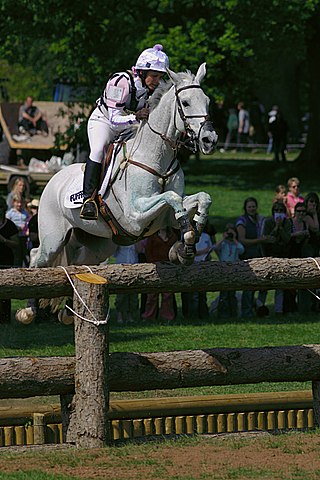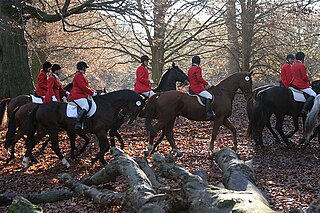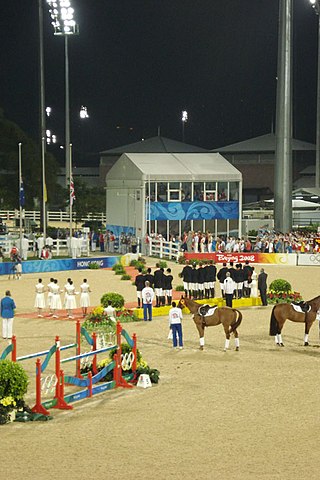Show jumping is a part of a group of English riding equestrian events that also includes eventing, hunters, and equitation. Jumping classes are commonly seen at horse shows throughout the world, including the Olympics. Sometimes shows are limited exclusively to jumpers. Sometimes jumper classes are offered in conjunction with other English-style events. Sometimes, show jumping is but one division of a very large, all-breed competition that includes a very wide variety of disciplines. Jumping classes may be governed by various national horse show sanctioning organizations, such as the United States Equestrian Federation or the British Showjumping Association. International competitions are governed by the rules of the International Federation for Equestrian Sports.

Eventing is an equestrian event where a single horse and rider combine and compete against other competitors across the three disciplines of dressage, cross-country, and show jumping. This event has its roots in a comprehensive cavalry test that required mastery of several types of riding. The competition may be run as a one-day event (ODE), where all three events are completed in one day or a three-day event (3DE), which is more commonly now run over four days, with dressage on the first two days, followed by cross-country the next day and then show jumping in reverse order on the final day. Eventing was previously known as Combined Training, and the name persists in many smaller organizations. The term "Combined Training" is sometimes confused with the term "Combined Test", which refers to a combination of just two of the phases, most commonly dressage and show jumping.

Cross country equestrian jumping is an endurance test that forms one of the three phases of the sport of eventing; it may also be a competition in its own right, known as hunter trials or simply "cross-country", although these tend to be lower-level, local competitions.
Equestrian competitions at the 1968 Summer Olympics in Mexico City, Mexico featured team and individual competitions in show jumping, eventing, and dressage. Mexico City proved a challenging site since it was 2,300 meters above sea level, resulting in 30% less oxygen in the air. The horses at the 1955 Pan American Games, which was also held in Mexico City, arrived a few weeks before the Games to adjust, but had difficulty in the competition. However, racehorses that competed at the same location and who were shipped in the day before, and left the day after the race, performed fine. It was discovered that although horses would adjust immediately to the high altitude during the first few days after arrival, they showed weakness and decreased performance around Day 10, which continued to Day 20. Therefore, nations were advised to ship in horses 3–4 weeks before the competition, which would allow them time to recover from the long travel, as well as adjust to the difference in altitude. Argentina, Ireland, and the USSR were the first to ship horses over, who arrived mid-September. France and Germany were the last countries to send their horses, who arrived 28 September 20 days before the competition was to start.

The equestrian program at the 1912 Summer Olympics in Stockholm, included five medal events. There were individual competitions in dressage, eventing, and show jumping. Team scores were also gathered and medals awarded for teams in the eventing and jumping competitions. Equestrian had been absent from the Olympic program since the 1900 Summer Olympics, making the 1912 Games the second time the sport was featured. Ten nations competed: Belgium, Chile, Denmark, France, Germany, Great Britain, Norway, Russia, Sweden, and the USA. Only Sweden and Germany were able to supply a full team for all three disciplines, with several countries having several riders and horses used in two or even all three disciplines. A total of 88 entries ran in the three events, with 62 riders and 70 horses.

The equestrian events at the 1936 Berlin Summer Olympics included dressage, eventing, and show jumping. All three disciplines had both individual and team competitions. The host country, Germany, had a stellar year, winning both individual and team gold in every equestrian event, as well as individual silver in dressage. The competitions were held from 12 to 16 August 1936. Moderately priced tickets meant huge crowds at all equestrian events, with 15,000–20,000 spectators at any time during the dressage competition, 60,000 on the endurance day of eventing, and 120,000 for the Nations Cup in jumping.
The equestrian events at the 1972 Summer Olympics in Munich included show jumping, dressage and eventing. All three disciplines had both individual and team competitions. The equestrian competitions were held at 3 sites: an existing equestrian facility at Riem for the individual show jumping and eventing competitions, the Olympic Stadium in Munich for the Nations Cup, and Nymphenburg, a Baroque palace garden, for the sold-out dressage. 179 entries, including 31 women, competed from 27 countries: Argentina, Australia, Austria, Belgium, Bolivia, Bulgaria, Brazil, Canada, Chile, Denmark, German Democratic Republic (GDR), France, Federal Republic of Germany (FRG), Great Britain, Hungary, Ireland, Italy, Japan, Mexico, the Netherlands, Poland, Portugal, Soviet Union, Spain, Sweden, Switzerland, and the USA. The youngest participant was Kurt Maeder from Switzerland at 19 years old, while the oldest rider was Lorna Johnstone from Great Britain at 70 years old.
The European Eventing Championships, like most other European Championships, is held every two years. Today it is a four star eventing competition. A four star event is one step down from the grand slam which consists of three five star events.

A field hunter, or a fox hunter, is a type of horse used in the hunt field for fox hunting and stag hunting.

The Hunter division is a branch of horse show competition that is judged on the horse's performance, soundness and when indicated, conformation, suitability or manners. A "show hunter" is a horse that competes in this division.

Hunt seat is a style of forward seat riding commonly found in North American horse shows. Along with dressage, it is one of the two classic forms of English riding. The hunt seat is based on the tradition of fox hunting. Hunt seat competition in North America includes both flat and over fences for show hunters, which judge the horse's movement and form, and equitation classes, which judge the rider's ability both on the flat and over fences. The term hunt seat may also refer to any form of forward seat riding, including the kind seen in show jumping and eventing.

Mountain bike racing is the competitive cycle sport discipline of mountain biking held on off-road terrain. The Union Cycliste Internationale (UCI) recognised the discipline relatively late in 1990, when it sanctioned the world championships in Durango, Colorado. The first UCI Mountain Bike World Cup series took place in 1988. Its nine-race circuit covered two continents—Europe and North America—and was sponsored by Grundig. Cross-country racing was the only World Cup sport at this time. In 1993, a six-event downhill World Cup was introduced. In 1996, cross-country mountain biking events were added to the Olympic Games. In 2006, cross-country mountain biking events became part of the World Deaf Cycling Championships for the first time in San Francisco, USA.

Equestrian sports were first included in the Olympic Games in the Summer Olympics of 1900 in Paris. They were again included in 1912, and have been included in every subsequent edition of the Games. The Olympic equestrian disciplines are dressage, eventing, and show-jumping. In each discipline, both individual and team medals are awarded. Women and men compete on equal terms.

The Equestrian events included three disciplines: dressage, eventing, and show jumping, and were held at the Deodoro Military Club.
Trail is a competitive class at horse shows where horses and riders in western-style attire and horse tack navigate a series of obstacles. Contestants ride the course one at a time. Originally designed to resemble situations a horse and rider might actually encounter when on a trail in a natural habitat, modern trail classes now tend to focus more heavily on agility and manners, with courses bearing very little resemblance to real-world natural trails.
Various obstacles are found in competitive sports involving horse jumping. These include show jumping, hunter, and the cross-country phase of the equestrian discipline of eventing. The size and type of obstacles vary depending on the course and the level of the horse and rider, but all horses must successfully negotiate these obstacles in order to complete a competition. Fences used in hunter and eventing are generally made to look relatively rustic and natural.

The team eventing at the 2008 Summer Olympics took place between August 9 and 12 at the Hong Kong Sports Institute.

The individual eventing event at the 2020 Summer Olympics is scheduled to take place from 30 July to 2 August 2021 at the Baji Koen and Sea Forest Cross-Country Course. Like all other equestrian events, the eventing competition is open-gender, with both male and female athletes competing in the same division. 65 riders from 29 nations are expected to compete.

The team eventing event at the 2020 Summer Olympics is scheduled to take place from 30 July to 2 August 2021 at the Baji Koen and Sea Forest Cross-Country Course. Like all other equestrian events, the eventing competition is open-gender, with both male and female athletes competing in the same division. 45 riders from 15 nations are expected to compete.

Rotational falls occur when a horse falls in such a manner as to somersault before landing on its back. It is of particular concern in the sport of eventing, especially in the cross country phase of the competition. These falls can cause grave injuries and in the past have resulted in fatalities; such fatalities have spiked in recent years, prompting investigations and movements worldwide to increase the safety for participants.














